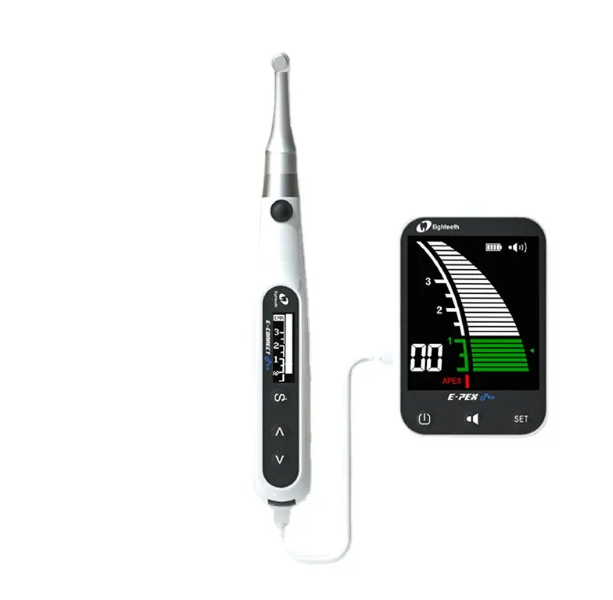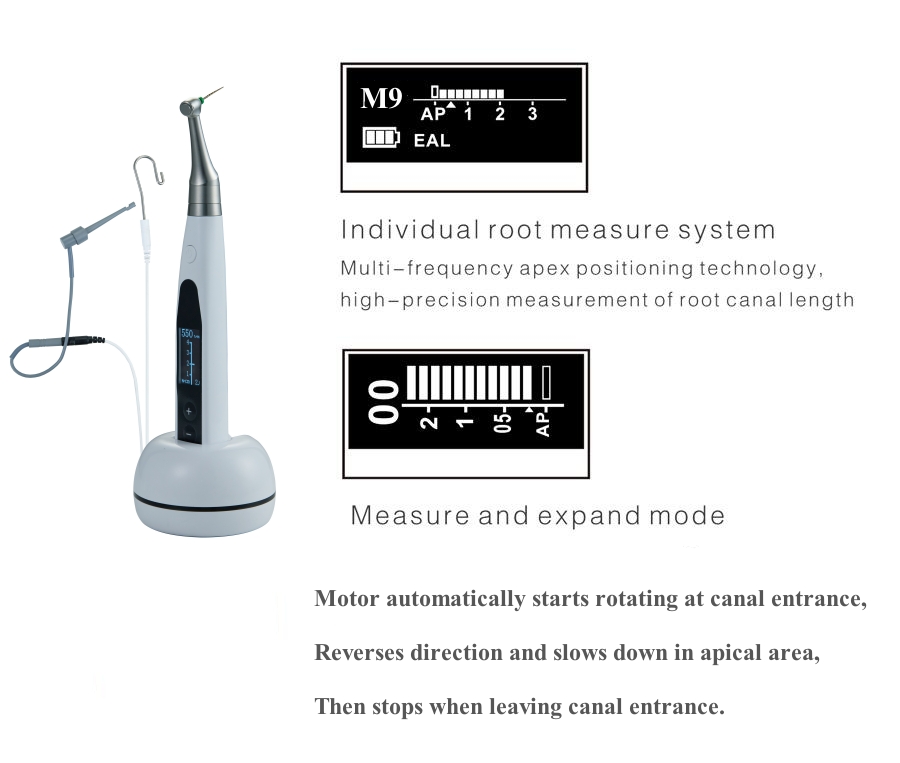Reciprocating motion is becoming an increasingly popular approach in endodontic root canal preparation. But why is this alternating rotation so advantageous compared to traditional continuous rotation? In this article, we’ll explore the main benefits of using reciprocation and how it is impacting modern root canal therapy.
Why need reciprocating motion in endodontics
Reciprocating motion refers to an alternating clockwise and counterclockwise rotation used during root canal instrumentation. This is in contrast to continuous rotation in one direction.
Reciprocating motion is designed to reduce torsional stress on endodontic files and decrease the risk of file separation or fracture during cleaning and shaping procedures.
It enhances canal centering and improves cutting efficiency while minimizing the chances of ledging, transportation, or perforation of the root canal system.
Reciprocation allows the file to periodically disengage dentin and enables improved debris removal compared to continuous rotation.
How does endo motor work on reciprocating mode
Endodontic motors can operate reciprocating files in two main ways:
1. Pre-set reciprocation mode:
Here, the angles of reciprocation (clockwise and counterclockwise rotation) are fixed and pre-programmed into the endo motor.
For example, a file like WaveOne Gold has a fixed reciprocation of 170° counterclockwise and 50° clockwise rotation. This is built into the motor and not changed during use.
2.Adaptive Torque Control (ATC):
Motors with ATC monitor torque levels and can dynamically adjust the reciprocation angle based on feedback from the file.
This allows the reciprocation motion to adapt in real-time to the unique anatomy of each canal.
The reciprocation angle changes automatically to maintain optimum cutting efficiency and prevent file separation when high torque levels are sensed.
ATC aims to improve safety and prevent file fracture compared to fixed reciprocation.
So in summary, pre-set reciprocation uses fixed angles while ATC adapts the angles in real-time based on torque feedback from the file. The goal of both is safe and efficient reciprocating motion.
Best Two Endo Motor Reciprocating Features
- Endo motor with 1:1 handpiece, maximum 1000rpm

It features a brushless motor, integrated apex locator, color display, and wireless functionality, streamlining root canal measurements and treatments. With adjustable speed, torque, sensitivity, and automated apical features, it can be customized to suit every patient’s needs. Plus, the ergonomic and ambidextrous design enhances performance and productivity, and the 360° Rotatable Contra Angle and torque calibration protect delicate root canals.
The endo motor allows ATC, reciprocating rotation mode, and build in 5 Pre-set reciprocation modes in M0.
5 Pre-set reciprocation modes:
| MODE | MOTION | DESCRIPTION |
|---|---|---|
| 1 | Fwd 150°-Rev 30° | For continuous rotation files |
| 2 | Fwd 180°-Rev 30° | For continuous rotation files |
| 3 | Fwd 210°-Rev 30° | For continuous rotation files |
| 4 | Fwd 250°-Rev 30° | For continuous rotation files |
| 5 | Fwd 30°-Rev 150° | For reciprocating files |
Technical table:
| Parameter | Specification |
|---|---|
| Display | Color TFT display |
| Apex Locator | Connected, adjustable sensitivity |
| Apical Control | Auto start/stop, apical reverse, apical slow down |
| Working Modes | Forward, reverse, adaptive, reciprocating |
| Memory | 9 programmable memory slots (M1-M9) Build in 5 pre-set reciprocating modes |
| Speed Range | 120-1000 rpm |
| Torque Range | 0.5-4.0 Ncm |
| Handpiece | 1:1 mini contra-angle |
| Battery | 1500 mAh capacity |
- Endo motor with 16:1 handpiece, maximum 550rpm
The New Endo Motor Reciprocating System: the perfect tool for efficient and safe root canal preparation!
This system, combined with the integrated apex locator, allows for precise and controlled file advancement while monitoring the canal length. The motor’s automated functions, such as auto start/stop/reverse and torque monitoring, ensure that the file tip is always at the right distance from the apex. The enlarged interface provides visual feedback when the anatomical apex is near, allowing you to avoid overinstrumentation.

Technical table:
| Parameter | Specification |
|---|---|
| Torque Range | 0.3-4.0 Ncm |
| Speed Range | 140-550 rpm |
| Handpiece | 16:1 reduction mini head |
| Battery | 800 mAh Lithium rechargeable battery |
| Working Modes | M0-M9: 10 custom endo modes, allowing ATC, and Reciprocation M9: Apex locating mode |
| Apex Locator | Integrated, Accuracy: ±0.5 mm |
| Measurement Range | 0-99 mm |
| Display | LED display shows enlarged canal on apex approach |
| File Compatibility | All ISO endo files and systems |
Conclusion
In conclusion, reciprocating motion offers distinct advantages that are transforming modern root canal preparation techniques. The alternating clockwise and counterclockwise rotation is designed to minimize stress on endodontic files, enhance cutting efficiency, improve canal centering, and enable better debris removal.
While continuous rotation can lead to file separation or fracture, reciprocation allows the file to periodically disengage dentin for improved safety. Systems like WaveOne, Reciproc, and Adaptive Motion provide preset angles or allow adaptive torque control to optimize the reciprocating motion.
With the flexibility of pre-programmed motors or real-time feedback, reciprocation enables canal shaping with fewer instruments. Although reciprocating motion has limitations in certain complex anatomies, the overall benefits of increased safety, reduced file failures, and predictable shaping make it an important advancement in endodontic therapy.
-
 Flexible Double-Orifice Endodontic Irrigation Needle
Flexible Double-Orifice Endodontic Irrigation Needle -
 Disposable Endodontic Irrigation Syringes with Luer Lock and Precision Tips
Disposable Endodontic Irrigation Syringes with Luer Lock and Precision Tips -
 64:1 Reduction CA Handpiece – Enhanced Control & Visibility for Root Canals
64:1 Reduction CA Handpiece – Enhanced Control & Visibility for Root Canals -
 Endo-NiTi Handpiece 128:1 – Advanced Root Canal Preparation Instrument
Endo-NiTi Handpiece 128:1 – Advanced Root Canal Preparation Instrument -
 Smooth Glide Path Endo Files
Smooth Glide Path Endo Files -
 Next Endo Rotary Files: Advanced Curved Canal Shaping for Precision Endodontics
Next Endo Rotary Files: Advanced Curved Canal Shaping for Precision Endodontics -
 All-in-One System for Scaling, Periodontics & Endodontics
All-in-One System for Scaling, Periodontics & Endodontics -
 Obturation Pen for Root Canal Therapy
Obturation Pen for Root Canal Therapy -
 3D Obturator Handpiece Filling System
3D Obturator Handpiece Filling System -
 ProApex Apex Locator
ProApex Apex Locator -
 Endo Motor Apex Locating System
Endo Motor Apex Locating System -
 Endodontic File Removal System
Endodontic File Removal System -
 Speed 16:1 Endodontic Handpiece
Speed 16:1 Endodontic Handpiece -
 U File Tips
U File Tips -
 Reciprocating Endodontic File
Reciprocating Endodontic File -
 Rotary Files Wave One Gold System
Rotary Files Wave One Gold System -
 Endo Handpiece For Apex Locator
Endo Handpiece For Apex Locator -
 Contra angle Endo Handpiece
Contra angle Endo Handpiece -
 4:1 Contra-angle Hand piece
4:1 Contra-angle Hand piece -
 Root canal Gutta percha Points
Root canal Gutta percha Points -
 Root Canal Paper Points Color-Coded
Root Canal Paper Points Color-Coded -
 Gutta Percha Points Endodontic Pro Tapers
Gutta Percha Points Endodontic Pro Tapers -
 Endodontic Pro Tapers Paper Points
Endodontic Pro Tapers Paper Points -
 Protaper Blue Files Endodontics
Protaper Blue Files Endodontics -
 Endodontic Spacers
Endodontic Spacers -
 Apex Locator With 16:1 Mini Contra-angle ATC Reciprocating Setting
Apex Locator With 16:1 Mini Contra-angle ATC Reciprocating Setting -
 Endo Motor Wireless Maximum 1000rpm
Endo Motor Wireless Maximum 1000rpm -
 Dental Niti D File
Dental Niti D File -
 Peeso Reamers
Peeso Reamers -
 Dental Gates Drill
Dental Gates Drill -
 LED Light Dental Handpiece High Speed
LED Light Dental Handpiece High Speed -
 FG Diamond Burs Dental
FG Diamond Burs Dental -
 Zekrya Endo Z Safe Carbide Burs Dental
Zekrya Endo Z Safe Carbide Burs Dental -
 Contra Angle Carbide Burs Dental
Contra Angle Carbide Burs Dental -
 Dental Headstroem Files
Dental Headstroem Files -
 Endo Dental K File
Endo Dental K File
